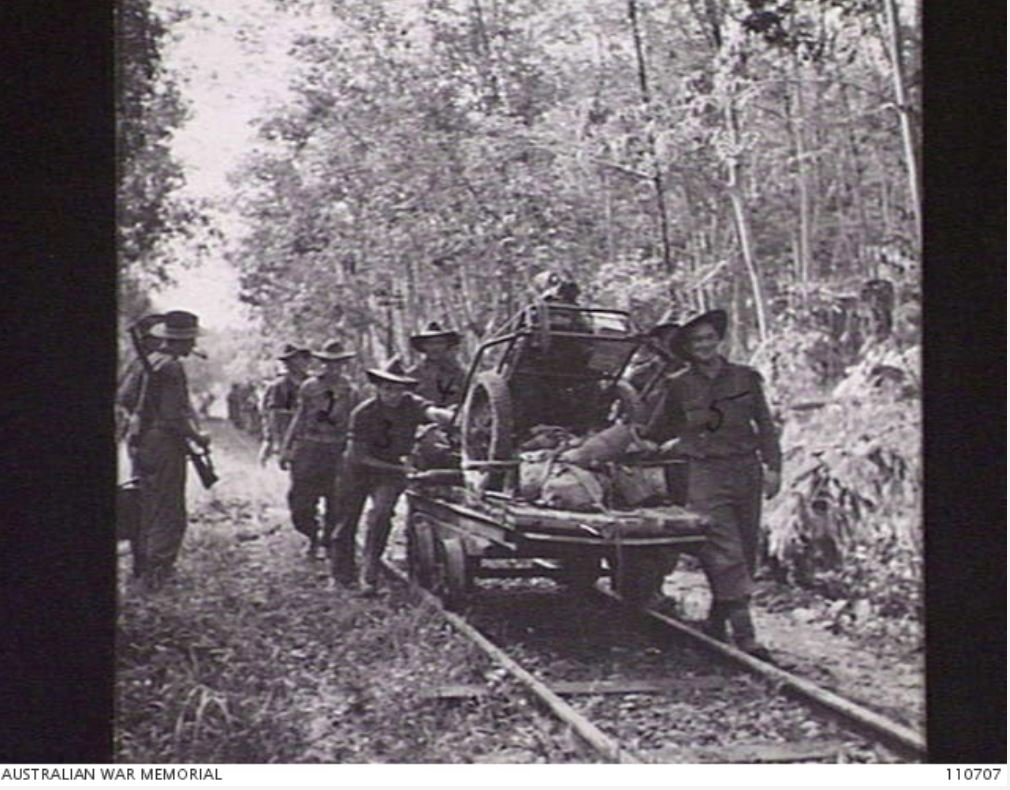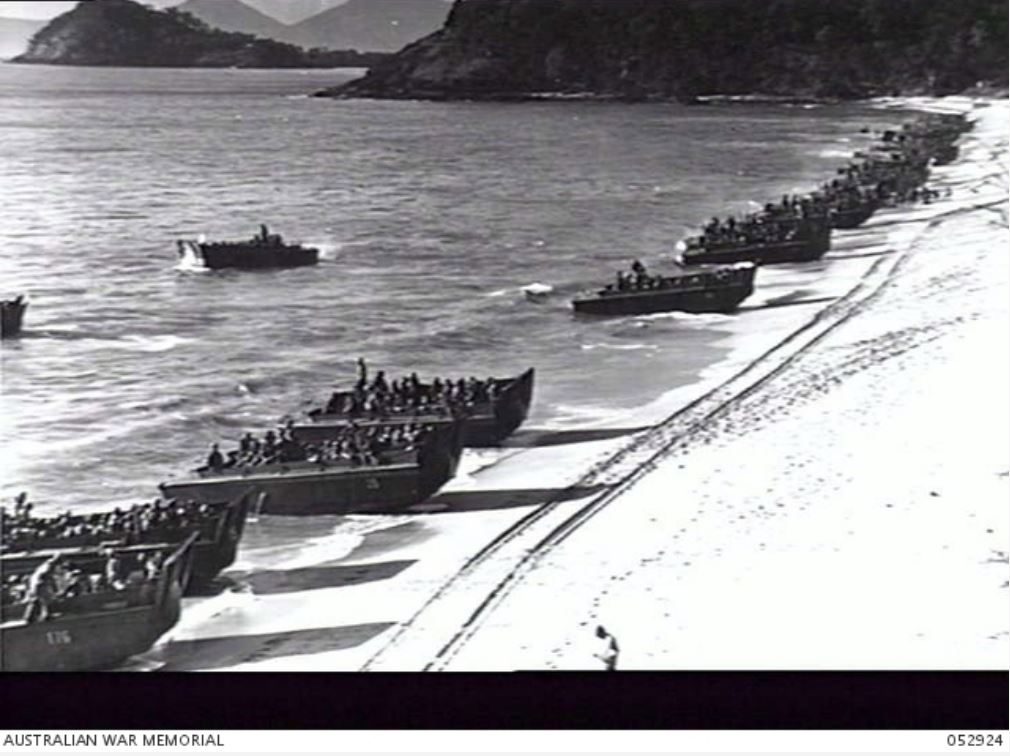Difference between revisions of "2/28th Australian Infantry Battalion"
From Our Contribution
(→Battalion personnel) |
(→Battalion personnel) |
||
| Line 44: | Line 44: | ||
* † [[John Hector Russell MacDonald]] ??? - 18 Jul 1942 - KIA 18 Jul 1942 | * † [[John Hector Russell MacDonald]] ??? - 18 Jul 1942 - KIA 18 Jul 1942 | ||
* [[Robert Archibald Edwin Mack]] | * [[Robert Archibald Edwin Mack]] | ||
| − | * [[Lawrence Gerald McDonough]] 5 Nov 1942 - 30 May 1943 | + | * [[Lawrence Gerald McDonough]] 5 Nov 1942 - 30 May 1943 & 15 May - 27 Oct 1944 |
* [[Stanton Edward McKenna]] POW | * [[Stanton Edward McKenna]] POW | ||
* † [[Andrew McKenzie]] ??? - 27 Jul 1942 - POW Runin Ridge - Died in captivity 17 Aug 1942 | * † [[Andrew McKenzie]] ??? - 27 Jul 1942 - POW Runin Ridge - Died in captivity 17 Aug 1942 | ||
Revision as of 01:37, 20 December 2020
Contents
Brief History
The 2/28 Aust Infantry battalion was raised in Melville in July 1940 as part of the 24th Aust Infantry Brigade, 9th Infantry Division, and it moved to Northam in September to undergo training. The other two battalions of the brigade were already in England, and the 2/28th joined up with them in Khassa, Palestine in February 1941 having left Fremantle in January.
With the Italians driven back beyond Benghazi, the 9th Division relieved the 6th Division, and the 2/28th Battalion moved to Tobruk to complete their training and to provide support for the 9th Division. When the German attack on Tobruk commenced, the 2/28th were manning the western perimeter defences and turned back he first attacking forces. Over time they rotated through all the positions before being relieved on 23 Sep 1941, sailing to Alexandria. From here they transferred to Kilo 89 in Palestine, and from there to Haret Jedide, Syria and then Lebanon to rest and rebuild while performing Garrison duties. The German advance reached El Alamein by July and the 9th Division was rushed to the Alamein "box", and held the northern, coastal sector for four months until the British Army could be reinforced to undertake an offensive of their own. The 2/28th had initially been left in Alexandria to defend it, and so it was 10 July before they arrived at El Alamein. On the night of 26/27 July the 2/28th attacked Ruin Ridge and within an hour were on the feature, but being attacked by Germans to their rear. Cut off without ammunition resupply, and with British attempts to reach them defeated, when they were attacked by German tanks from three directions it was obvious that they could not hold out and once 'A' Company was overrun the battalion's commander had no choice but to surrender. Rounded up, they were then marched through the British artillery barrage which caused further casualties. Sixty five soldiers were killed, nearly 500 were captured, and only 92 remained to be withdrawn and the unit rebuilt before being back in action by September.
When the major British offensive began on 23 October, the 2/28th was in reserve, and was not committed to the battle until the night of 31 October when the 24th Brigade replaced the 26th Brigade in the "Saucer" where heavy fighting occurred. By 6 November enemy forces were retreating, but rather than be involved in the follow up, the 2/28 as withdrawn, sent to Gaza in Palestine prior to moving to the Suez Canal and ships for home, arriving in Fremantle on 18 Feb 1943.
The battalion was re-organised for jungle warfare, and was sent to New Guinea to participate in the landing at Red Beach, north west of Lae in September. With the fall of Lae, a landing was made north of Finschhafen, and on 14 October the 2/28tharrived at Scarlet Beach several days before the strong Japanese counter attack which was repulsed. Moving inland, the 2/28th captured Pino and Pabu before following the coast to capture Guiska. The battalion spent Christmas 1943 at Wareo before returning to Australia in late January 1944.
In Australia they gathered at Ravenshoe in North Queensland and underwent a lengthy period of training before travelling to Morotai in April 1945. Morotai was a staging post for the amphibious landings on the island of Borneo, with the 24th Brigade (included 2/28th Battalion) landing on what was known as "Brown Beach" on Labuan island on 10 June. It took the 2/28th and 2/43rd Battalions 11 days to clear teh island with most resistance coming from an area known as the "Pocket". The 2/28th then moved to Beaufort, spending teh final days of the war patrolling the surrounding area.
Following the end of the war and Japan's surrender, the ranks of the 2/28th thinned, as men were discharged, transferred, or volunteered for the occupation force for Japan. They returned to Australia in January 1946, where the 2/28th was disbanded. Two men were captured in Malaya by the Japanese, and 269 others died while members of the unit.
Battalion personnel
- Harold Baldwin
- † George Brushmeyer ??? - 16 Oct 1943 - DOW New Guinea
- Joseph James Burrows 18 Nov 1941 - 27 Jul 1942 - POW Ruin Ridge
- Albert William Chadwick 5 Sep 1940 - 11 Apr 1943
- Herbert James Collier 15 Aug 1940 - 27 Jul 1942 - POW Ruin Ridge
- Robert Gale 26 Jul 1940 - 31 Mar 1941 ?????
- Charles Henry Walter Hansen WIA
- Stanley Rudolph Jarvis 27 Apr 1942 - 27 Jul 1942 POW Ruin Ridge
- † John Hector Russell MacDonald ??? - 18 Jul 1942 - KIA 18 Jul 1942
- Robert Archibald Edwin Mack
- Lawrence Gerald McDonough 5 Nov 1942 - 30 May 1943 & 15 May - 27 Oct 1944
- Stanton Edward McKenna POW
- † Andrew McKenzie ??? - 27 Jul 1942 - POW Runin Ridge - Died in captivity 17 Aug 1942
- Victor Henry Mead
- Thomas Stanley O'Meagher WIA x 2
- Walter Vivian Ernest Peters
- Frederick Joseph Powell
- George Lawrance Pryor
- John Peter Lewis Rymer
- Edward Arthur Sewell
- † David John Sexty ??? - 3 Aug 1941 - KIA Tobruk
- Norman Rees Willacott MID
Battle Honours
- Beaufort
- Borneo
- Busu River
- Defence of Alamein Line
- Defence of Scarlet Beach
- Defence of Tobruk
- El Alamein
- Finschhafen
- Gusika
- Labuan
- Qattara Track
- Sanyet el Miteirya
- Siki Cove
- Tell el Makh Khad
Individual Honours
- 2 x Distinguished Service Order
- 6 x Military Cross
- 4 x Distinguished Conduct Medal
- 15 x Military Medal
- 51 x Mentioned in Despatches
Notes
Content has come from The Unit Guide - Volume 2 - The Australian Army 1939-1945 - pages 2.327 to 2.329 - Graham R McKenzie-Smith - Big Sky Publishing - 2018; and the Australian War Memorial.


